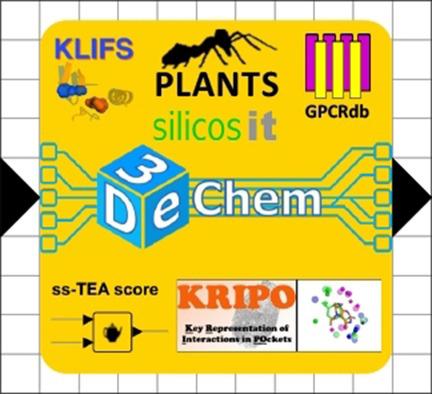当前位置:
X-MOL 学术
›
ChemMedChem
›
论文详情
Our official English website, www.x-mol.net, welcomes your feedback! (Note: you will need to create a separate account there.)
3D-e-Chem: Structural Cheminformatics Workflows for Computer-Aided Drug Discovery.
ChemMedChem ( IF 3.4 ) Pub Date : 2018-02-14 , DOI: 10.1002/cmdc.201700754 Albert J Kooistra 1, 2 , Márton Vass 2 , Ross McGuire 1, 3 , Rob Leurs 2 , Iwan J P de Esch 2 , Gert Vriend 1 , Stefan Verhoeven 4 , Chris de Graaf 2
ChemMedChem ( IF 3.4 ) Pub Date : 2018-02-14 , DOI: 10.1002/cmdc.201700754 Albert J Kooistra 1, 2 , Márton Vass 2 , Ross McGuire 1, 3 , Rob Leurs 2 , Iwan J P de Esch 2 , Gert Vriend 1 , Stefan Verhoeven 4 , Chris de Graaf 2
Affiliation

|
eScience technologies are needed to process the information available in many heterogeneous types of protein-ligand interaction data and to capture these data into models that enable the design of efficacious and safe medicines. Here we present scientific KNIME tools and workflows that enable the integration of chemical, pharmacological, and structural information for: i) structure-based bioactivity data mapping, ii) structure-based identification of scaffold replacement strategies for ligand design, iii) ligand-based target prediction, iv) protein sequence-based binding site identification and ligand repurposing, and v) structure-based pharmacophore comparison for ligand repurposing across protein families. The modular setup of the workflows and the use of well-established standards allows the re-use of these protocols and facilitates the design of customized computer-aided drug discovery workflows.
中文翻译:

3D-e-Chem:计算机辅助药物发现的结构化学信息学工作流程。
需要电子科学技术来处理许多异质类型的蛋白质-配体相互作用数据中的可用信息,并将这些数据捕获到模型中,从而能够设计出有效且安全的药物。在这里,我们展示科学的 KNIME 工具和工作流程,能够整合化学、药理学和结构信息,用于:i) 基于结构的生物活性数据映射,ii) 基于结构的配体设计支架替代策略识别,iii) 基于配体目标预测,iv) 基于蛋白质序列的结合位点识别和配体重新利用,以及 v) 基于结构的药效团比较,用于跨蛋白质家族的配体重新利用。工作流程的模块化设置和完善标准的使用允许重复使用这些协议,并促进定制计算机辅助药物发现工作流程的设计。
更新日期:2018-02-14
中文翻译:

3D-e-Chem:计算机辅助药物发现的结构化学信息学工作流程。
需要电子科学技术来处理许多异质类型的蛋白质-配体相互作用数据中的可用信息,并将这些数据捕获到模型中,从而能够设计出有效且安全的药物。在这里,我们展示科学的 KNIME 工具和工作流程,能够整合化学、药理学和结构信息,用于:i) 基于结构的生物活性数据映射,ii) 基于结构的配体设计支架替代策略识别,iii) 基于配体目标预测,iv) 基于蛋白质序列的结合位点识别和配体重新利用,以及 v) 基于结构的药效团比较,用于跨蛋白质家族的配体重新利用。工作流程的模块化设置和完善标准的使用允许重复使用这些协议,并促进定制计算机辅助药物发现工作流程的设计。



























 京公网安备 11010802027423号
京公网安备 11010802027423号